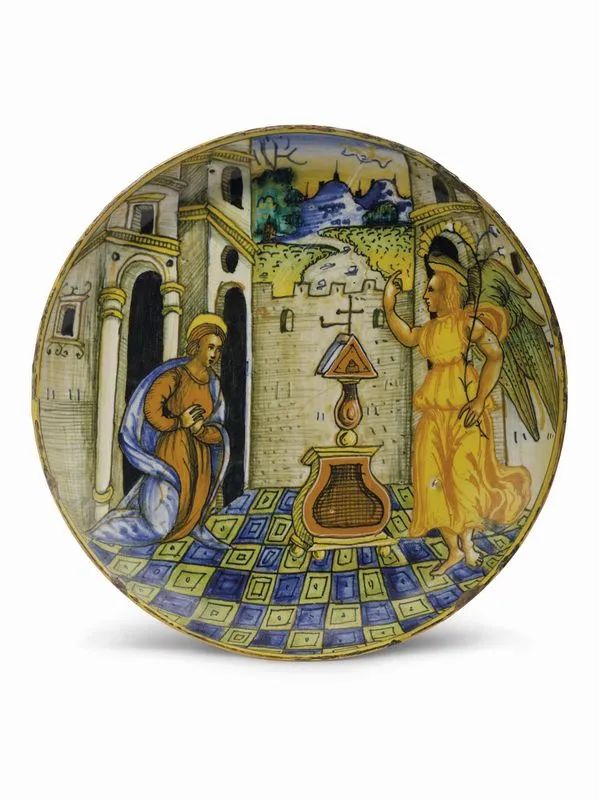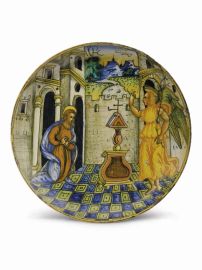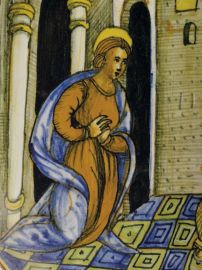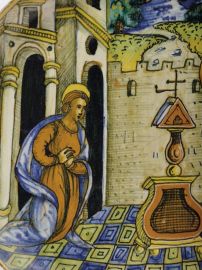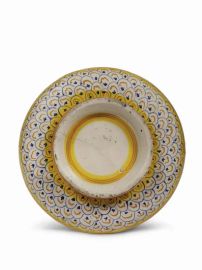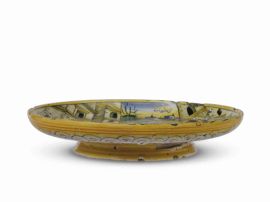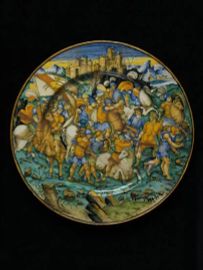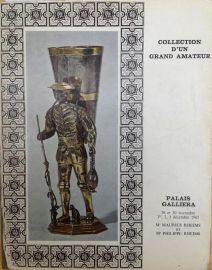SHALLOW BOWL, FAENZA, BALDASSARRE MANARA OR HIS WORKSHOP, AROUND 1540
SHALLOW BOWL
FAENZA, BALDASSARRE MANARA OR HIS WORKSHOP, AROUND 1540
Polychrome earthenware painted in orange, antimony yellow, green, blue, brownish manganese, black, brown and tin white.
High cm 4,2, diam. cm 22,1, foot diam cm 12,8
Provenance
Adda Collection, London;
Collection d’un grand amateur, Palais Galliera, Paris, November, 29th 1965, no. 574;
Caruso Collection, Sotheby’s, London, March, 20th 1973, no. 38;
Private Collection, Milan
Literature
B. Rackham, Islamic Pottery and Italian Maiolica. Illustrated Catalogue of a Private Collection, London 1959, no. 299;
F. Liverani, R. Bosi, Maioliche di Faenza, Imola 1974, pp. 54 et seq. no. XI;
C. Ravanelli Guidotti, Baldassare Manara Faentino pittore di maioliche nel Cinquecento, Ferrara 1996, p. 230 no. A8
This shallow bowl presents a concave cavetto and a raised edge, ending with a thin rounded rim and stands on a short foot with a slightly arched rim.
The scene develops through the entire bowl length including the concave cavetto, and depicts the Annunciation: the Archangel Gabriel and the Virgin are portrayed following iconographic canons of the Renaissance. In the centre of the scene the two figures are separated by the bookstand which symbolizes the prayer and the meditation of the Virgin Mary waiting to accomplish her mission. On the right, we see Gabriel raising his right index finger, pointing at the sky and holding a long lily with his left hand, as a symbol of the spiritual motherhood of Mary, while on the left, the kneeling Virgin is receiving the Archangel's message with humility and praying with joined hands. This representation features many architectural elements, including a tiled floor, a palace with vaulted arches, some columns and large cornices behind the Virgin and a circular tower behind the Archangel. A high crenellated wall encloses the entire scene as a hortus conclusus and leaves outside in the background a landscape with mountains and a winding white street.
The entirely ochre-painted back of the dish has an imbricate motif and yellow bands with light blue brushstrokes.
Despite the abundant use of enamel and of pigments, the drawing appears inaccurate and imperfect and lacks the grace that normally characterizes the works of the painter. The pigments are carefully applied on this shallow bowl, even if some baking flaws and some discoloration on the rim are evident on the back of the dish.
Although without the artist's signature, this shallow bowl has been attributed to Baldassare Manara or to his workshop and has been mentioned among the uncertain works in the monograph on Baldassarre Manara (op. cit, p. 230 no. A8) by Carmen Ravanelli Guidotti. The careful attribution of this dish, due to the "imperfection of the drawing", has not prevented scholars from ascribing this work, which belonged to the renowned Adda Collection of London, to the master of Faenza or to his workshop. The characters' faces recall the other master's works and probably take inspiration from engravings in the artist's workshop. In fact, the kneeling Virgin with joined hands is similar to another one in the scene of the Adoration of the Shepherds (Bartsch?), even if with a more incisive line: here the figure of the kneeling Virgin is inspired by an engraving of Marcantonio Raimondi after Francia (fig. 1), that was also widespread in other workshops of Faenza.
The rapid drawing style and less accuracy of the composition, however, do not exclude to ascribe this work to Baldassare. In fact, if we ignore the reference to the above-mentioned engraving, this work is characterized by a certain expressive freedom in the subject, which contributes to the hypothesis that the master was "accustomed" to decorating pottery. In her analysis, Carmen Ravanelli Guidotti highlights some elements of this work: first of all, the rapid execution of the composition, second, a pictorial incongruity between the roughness of the stroke in the main scene and the ability to apply the chiaroscuro technique on the landscape in the background, and, third, the lack of some complementary symbolic elements present in the representations of the Annunciation, such as the dove and the central bookstand.
However, the artist of this shallow bowl seems to be an expert in the intensive use of pigments and in the technique of the enamel decoration, here rich in bright colours: absent are, instead, the white touches and only in the background the painter uses a very marked white touch on the architectural elements.
Since the large corpus of the works of Baldassarre Manara includes dozens of works, a detailed stylistic comparison could contribute to find similarities between Manara and the peculiar style of this painter.
Some scholars of Faenza have attributed the back of this shallow bowl to the workshop of Baldassare Manara or to other works ascribable to the master, as already specified by Carmen Ravanelli Guidotti. The decoration on the back is similar to another one on the back of a dish depicting Venus in Vulcan's Forge (Inv. c. 2113-1910) at the Victoria and Albert Museum of London. This proves that this decorative motif, recurring in various forms, was very popular in the workshops of Faenza in the first thirty years of the sixteenth century (like, for example, in the shallow bowl dated 1523 held at the Louvre Museum , inv. OA7579).
We would like to highlight the likely contribution of this artist in the painting of the faces of the two figures. This hypothesis derives from the comparison with two faces depicted on a magnificent dish with a battle at the Victoria and Albert Museum (Inv. c. 2112-1910): the knight's face on his skittish horse, on the left of the dish, is similar to that of the Virgin in our shallow bowl, as well as the foot soldier wearing a yellow lorica and turning his back, on the right of the scene, recalls the Archangel Gabriel's face (see fig. 2).
Similar to our dish, also in the rigidity of the line, is the extraordinary signed bowl at the John Paul Getty Museum depicting Saint Peter Saint Chiara and Saint Martyr (C. Hess, Italian Ceramics. Catalogue of the J. Paul Getty Museum Collection, Los Angeles 2002, pp. 170-173 no. 30, dated around 1535). The same gesture of the finger pointing at the sky represents a sort of stylistic hint for the figure of the Archangel of our plate. On her monograph on Baldassare Manara, Carmen Ravanelli Guidotti also highlights how this gesture represents a distinctive feature of the artist, whose figures “have stocky hands and short fingers ... with the index finger solemnly pointing at or raised to the sky” (op. cit., p. 67 figg. 19-19d).
This work could perhaps be included among the more mature works of Baldassarre Manara, in the years before his death around 1546/47 according to Carmen Ravanelli Guidotti (in a document dated June, 20th 1547 his wife is called “olim uxor”).
This dish appeared in the catalogue of the famous Adda Collection (see fig. 3), attributed by Rackham in 1959 to a workshop of Faenza. It was sold on the art market in 1973 as belonging to the workshop of Baldassare Manara, as confirmed by Bosi and Liverani in their publication of the following year.

